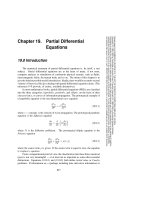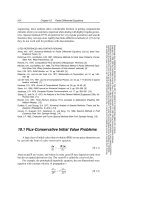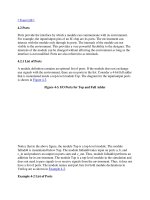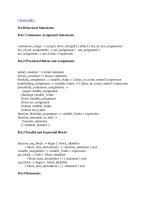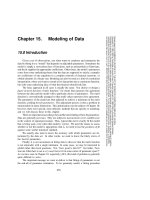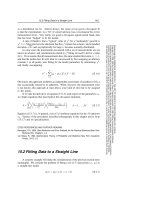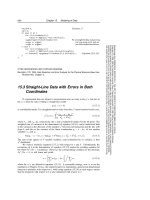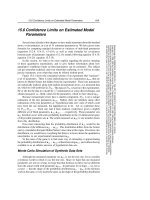Tài liệu Partial Differential Equations part 3 pptx
Bạn đang xem bản rút gọn của tài liệu. Xem và tải ngay bản đầy đủ của tài liệu tại đây (98.64 KB, 7 trang )
19.2 Diffusive Initial Value Problems
847
Sample page from NUMERICAL RECIPES IN C: THE ART OF SCIENTIFIC COMPUTING (ISBN 0-521-43108-5)
Copyright (C) 1988-1992 by Cambridge University Press.Programs Copyright (C) 1988-1992 by Numerical Recipes Software.
Permission is granted for internet users to make one paper copy for their own personal use. Further reproduction, or any copying of machine-
readable files (including this one) to any servercomputer, is strictly prohibited. To order Numerical Recipes books,diskettes, or CDROMs
visit website or call 1-800-872-7423 (North America only),or send email to (outside North America).
Roache, P.J. 1976,
Computational Fluid Dynamics
(Albuquerque: Hermosa). [7]
Woodward, P., and Colella, P. 1984,
Journal of Computational Physics
, vol. 54, pp. 115–173. [8]
Rizzi, A., and Engquist, B. 1987,
Journal of Computational Physics
, vol. 72, pp. 1–69. [9]
19.2 Diffusive Initial Value Problems
Recall the model parabolic equation, the diffusion equation in one space
dimension,
∂u
∂t
=
∂
∂x
D
∂u
∂x
(19.2.1)
where D is the diffusion coefficient. Actually, this equation is a flux-conservative
equation of the form considered in the previous section, with
F = −D
∂u
∂x
(19.2.2)
the flux in the x-direction. We will assume D ≥ 0, otherwise equation (19.2.1) has
physicallyunstablesolutions: A small disturbance evolves to become moreand more
concentrated instead of dispersing. (Don’t make the mistake of trying to find a stable
differencingscheme for a problemwhose underlyingPDEs arethemselves unstable!)
Even though (19.2.1) is of the form already considered, it is useful to consider
it as a model in its own right. The particular form of flux (19.2.2), and its direct
generalizations, occur quite frequently in practice. Moreover, we have already seen
that numerical viscosity and artificial viscosity can introduce diffusive pieces like
the right-hand side of (19.2.1) in many other situations.
Consider first the case when D is a constant. Then the equation
∂u
∂t
= D
∂
2
u
∂x
2
(19.2.3)
can be differenced in the obvious way:
u
n+1
j
− u
n
j
∆t
= D
u
n
j+1
− 2u
n
j
+ u
n
j −1
(∆x)
2
(19.2.4)
This is the FTCS scheme again, except that it is a second derivative that has been
differenced on the right-hand side. But this makes a world of difference! The
FTCS scheme was unstable for the hyperbolicequation; however, a quick calculation
shows that the amplification factor for equation (19.2.4) is
ξ =1−
4D∆t
(∆x)
2
sin
2
k∆x
2
(19.2.5)
The requirement |ξ|≤1leads to the stability criterion
2D∆t
(∆x)
2
≤ 1(19.2.6)
848
Chapter 19. Partial Differential Equations
Sample page from NUMERICAL RECIPES IN C: THE ART OF SCIENTIFIC COMPUTING (ISBN 0-521-43108-5)
Copyright (C) 1988-1992 by Cambridge University Press.Programs Copyright (C) 1988-1992 by Numerical Recipes Software.
Permission is granted for internet users to make one paper copy for their own personal use. Further reproduction, or any copying of machine-
readable files (including this one) to any servercomputer, is strictly prohibited. To order Numerical Recipes books,diskettes, or CDROMs
visit website or call 1-800-872-7423 (North America only),or send email to (outside North America).
The physical interpretation of the restriction (19.2.6) is that the maximum
allowed timestep is, up to a numerical factor, the diffusion time across a cell of
width ∆x.
More generally, the diffusion time τ across a spatial scale of size λ is of order
τ ∼
λ
2
D
(19.2.7)
Usually we are interested in modeling accurately the evolution of features with
spatial scales λ ∆x. If we are limited to timesteps satisfying (19.2.6), we will
need to evolve through of order λ
2
/(∆x)
2
steps before things start to happen on the
scale of interest. This number of steps is usually prohibitive. We must therefore
find a stable way of taking timesteps comparable to, or perhaps — for accuracy —
somewhat smaller than, the time scale of (19.2.7).
This goal poses an immediate “philosophical” question. Obviously the large
timesteps that we propose to take are going to be woefully inaccurate for the small
scales that we have decided not to be interested in. We want those scales to do
something stable, “innocuous,” and perhaps not too physically unreasonable. We
want to build this innocuous behavior into our differencing scheme. What should
it be?
There are two different answers, each of which has its pros and cons. The
first answer is to seek a differencing scheme that drives small-scale features to their
equilibrium forms, e.g., satisfying equation (19.2.3) with the left-hand side set to
zero. Thisanswer generally makes thebest physical sense; but, as wewillsee, itleads
to a differencing scheme (“fully implicit”)that is onlyfirst-order accurate in time for
the scales that we are interested in. The second answer is to let small-scale features
maintain their initial amplitudes, so that the evolution of the larger-scale features
of interest takes place superposed with a kind of “frozen in” (though fluctuating)
background of small-scale stuff. This answer gives a differencing scheme (“Crank-
Nicholson”) that is second-order accurate in time. Toward the end of an evolution
calculation, however, one might want to switch over to some steps of the other kind,
to drive the small-scale stuff into equilibrium. Let us now see where these distinct
differencing schemes come from:
Consider the following differencing of (19.2.3),
u
n+1
j
− u
n
j
∆t
= D
u
n+1
j+1
− 2u
n+1
j
+ u
n+1
j −1
(∆x)
2
(19.2.8)
This is exactly like the FTCS scheme (19.2.4), except that the spatial derivatives on
the right-hand side are evaluated at timestep n +1. Schemes with this character are
called fully implicit or backward time, by contrast with FTCS (which is called fully
explicit). To solve equation (19.2.8) one has to solve a set of simultaneous linear
equations at each timestep for the u
n+1
j
. Fortunately, this is a simple problem because
the system is tridiagonal: Just group the terms in equation (19.2.8) appropriately:
−αu
n+1
j −1
+(1+2α)u
n+1
j
− αu
n+1
j+1
= u
n
j
,j=1,2...J − 1(19.2.9)
where
α ≡
D∆t
(∆x)
2
(19.2.10)
19.2 Diffusive Initial Value Problems
849
Sample page from NUMERICAL RECIPES IN C: THE ART OF SCIENTIFIC COMPUTING (ISBN 0-521-43108-5)
Copyright (C) 1988-1992 by Cambridge University Press.Programs Copyright (C) 1988-1992 by Numerical Recipes Software.
Permission is granted for internet users to make one paper copy for their own personal use. Further reproduction, or any copying of machine-
readable files (including this one) to any servercomputer, is strictly prohibited. To order Numerical Recipes books,diskettes, or CDROMs
visit website or call 1-800-872-7423 (North America only),or send email to (outside North America).
Supplemented by Dirichlet or Neumann boundary conditions at j =0and j = J,
equation (19.2.9) is clearly a tridiagonal system, which can easily be solved at each
timestep by the method of §2.4.
What is the behavior of (19.2.8) for very large timesteps? The answer is seen
most clearly in (19.2.9), in the limit α →∞(∆t→∞). Dividing by α, we see that
the difference equations are justthe finite-differenceformof the equilibriumequation
∂
2
u
∂x
2
=0 (19.2.11)
What about stability? The amplification factor for equation (19.2.8) is
ξ =
1
1+4αsin
2
k∆x
2
(19.2.12)
Clearly |ξ| < 1 for any stepsize ∆t. Theschemeis unconditionally stable. Thedetails
of the small-scale evolution from the initial conditions are obviously inaccurate for
large ∆t. But, as advertised, the correct equilibrium solution is obtained. This is
the characteristic feature of implicit methods.
Here, on the otherhand,ishowone getsto thesecondof our abovephilosophical
answers, combining the stabilityof an implicit method with theaccuracy of a method
that is second-order in both space and time. Simply form the average of the explicit
and implicit FTCS schemes:
u
n+1
j
− u
n
j
∆t
=
D
2
(u
n+1
j+1
− 2u
n+1
j
+ u
n+1
j −1
)+(u
n
j+1
− 2u
n
j
+ u
n
j −1
)
(∆x)
2
(19.2.13)
Here both the left- and right-hand sides are centered at timestep n +
1
2
, so the method
is second-order accurate in time as claimed. The amplification factor is
ξ =
1 − 2α sin
2
k∆x
2
1+2αsin
2
k∆x
2
(19.2.14)
so the method is stable for any size ∆t. This scheme is called the Crank-Nicholson
scheme, and is our recommended method for any simple diffusion problem (perhaps
supplemented by a few fully implicit steps at the end). (See Figure 19.2.1.)
Now turn to some generalizations of the simple diffusion equation (19.2.3).
Suppose first that the diffusion coefficient D is not constant, say D = D(x). We can
adopt either of two strategies. First, we can make an analytic change of variable
y =
dx
D(x)
(19.2.15)
850
Chapter 19. Partial Differential Equations
Sample page from NUMERICAL RECIPES IN C: THE ART OF SCIENTIFIC COMPUTING (ISBN 0-521-43108-5)
Copyright (C) 1988-1992 by Cambridge University Press.Programs Copyright (C) 1988-1992 by Numerical Recipes Software.
Permission is granted for internet users to make one paper copy for their own personal use. Further reproduction, or any copying of machine-
readable files (including this one) to any servercomputer, is strictly prohibited. To order Numerical Recipes books,diskettes, or CDROMs
visit website or call 1-800-872-7423 (North America only),or send email to (outside North America).
t or n
x or j
FTCS
(a)
Fully Implicit
(b)
Crank-Nicholson
(c)
Figure 19.2.1. Three differencing schemes for diffusive problems (shown as in Figure 19.1.2). (a)
Forward Time Center Space is first-order accurate, but stable only for sufficiently small timesteps.
(b) Fully Implicit is stable for arbitrarily large timesteps, but is still only first-order accurate. (c)
Crank-Nicholson is second-order accurate, and is usually stable for large timesteps.
Then
∂u
∂t
=
∂
∂x
D(x)
∂u
∂x
(19.2.16)
becomes
∂u
∂t
=
1
D(y)
∂
2
u
∂y
2
(19.2.17)
and we evaluate D at the appropriate y
j
. Heuristically, the stability criterion (19.2.6)
in an explicit scheme becomes
∆t ≤ min
j
(∆y)
2
2D
−1
j
(19.2.18)
Note that constant spacing ∆y in y does not imply constant spacing in x.
An alternative method that does not require analytically tractable forms for
D is simply to difference equation (19.2.16) as it stands, centering everything
appropriately. Thus the FTCS method becomes
u
n+1
j
− u
n
j
∆t
=
D
j+1/2
(u
n
j+1
− u
n
j
) − D
j −1/2
(u
n
j
− u
n
j −1
)
(∆x)
2
(19.2.19)
where
D
j+1/2
≡ D(x
j+1/2
)(19.2.20)
19.2 Diffusive Initial Value Problems
851
Sample page from NUMERICAL RECIPES IN C: THE ART OF SCIENTIFIC COMPUTING (ISBN 0-521-43108-5)
Copyright (C) 1988-1992 by Cambridge University Press.Programs Copyright (C) 1988-1992 by Numerical Recipes Software.
Permission is granted for internet users to make one paper copy for their own personal use. Further reproduction, or any copying of machine-
readable files (including this one) to any servercomputer, is strictly prohibited. To order Numerical Recipes books,diskettes, or CDROMs
visit website or call 1-800-872-7423 (North America only),or send email to (outside North America).
and the heuristic stability criterion is
∆t ≤ min
j
(∆x)
2
2D
j+1/2
(19.2.21)
The Crank-Nicholson method can be generalized similarly.
The second complication one can consider is a nonlinear diffusion problem,
for example where D = D(u). Explicit schemes can be generalized in the obvious
way. For example, in equation (19.2.19) write
D
j+1/2
=
1
2
D(u
n
j+1
)+D(u
n
j
)
(19.2.22)
Implicit schemes are not as easy. The replacement (19.2.22) with n → n +1leaves
us with a nasty set of coupled nonlinear equations to solve at each timestep. Often
there is an easier way: If the form of D(u) allows us to integrate
dz = D(u)du (19.2.23)
analytically for z(u), then the right-hand side of (19.2.1) becomes ∂
2
z/∂x
2
,which
we difference implicitly as
z
n+1
j+1
− 2z
n+1
j
+ z
n+1
j −1
(∆x)
2
(19.2.24)
Now linearize each term on the right-hand side of equation (19.2.24), for example
z
n+1
j
≡ z(u
n+1
j
)=z(u
n
j
)+(u
n+1
j
− u
n
j
)
∂z
∂u
j,n
= z(u
n
j
)+(u
n+1
j
− u
n
j
)D(u
n
j
)
(19.2.25)
This reduces the problem to tridiagonal form again and in practice usually retains
the stability advantages of fully implicit differencing.
Schr
¨
odinger Equation
Sometimes the physical problem being solved imposes constraints on the
differencing scheme that we have not yet taken into account. For example, consider
the time-dependent Schr
¨
odinger equation of quantum mechanics. This is basically a
parabolic equation for the evolution of a complex quantity ψ. For the scattering of a
wavepacket by a one-dimensional potential V (x), the equation has the form
i
∂ψ
∂t
= −
∂
2
ψ
∂x
2
+ V (x)ψ (19.2.26)
(Here we have chosen units so that Planck’s constant ¯h =1and the particle mass
m =1/2.) One is given the initial wavepacket, ψ(x, t =0), together with boundary
